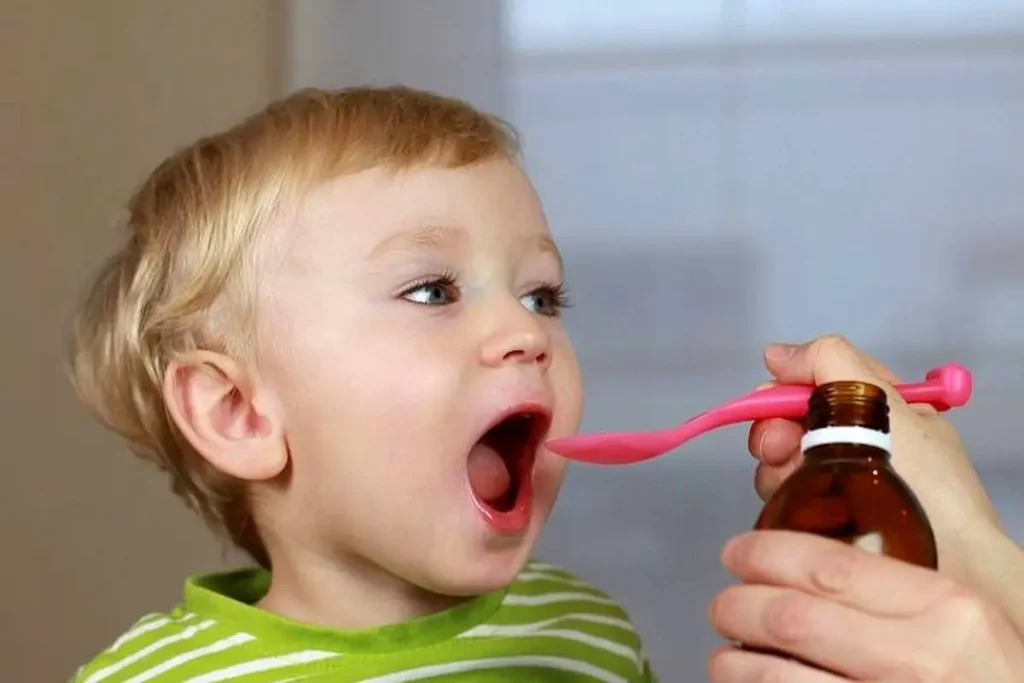Last Updated on November 14, 2025 by
Fever in kids worries parents all over the world. They look for the best and safest syrup to help. The top choices are acetaminophen and ibuprofen syrups.
Recent studies and guidelines show that both acetaminophen (found in childrens Tylenol) and ibuprofen work well and are safe for managing fever. The right choice depends on the child’s age, weight, and health history. Both medications have comparable safety profiles and efficacy, although ibuprofen may reduce fever slightly more effectively in some cases. Proper dosing and consideration of individual health factors are essential when choosing between the two.

Fevers in kids can worry parents a lot. But knowing when to treat them is key. A fever is the body’s way of fighting off an illness.

A fever is when a child’s body temperature hits 100.4 °F (38 °C) or higher. It can be caused by many things, like viruses or bacteria. Remember, a fever is a sign of something else going on, not the illness itself.
For babies under 3 months, a fever is a big worry. They might need to see a doctor right away. Older kids might not need medicine if they’re feeling okay.
Not every fever needs medicine. If your child is feeling fine, just watch their temperature. But if they’re uncomfortable or have other symptoms like a headache, Children’s Tylenol might help.
Choosing to use Tylenol for fever depends on your child’s age, weight, and health history. Always stick to the children’s Tylenol dose to avoid problems.
Most fevers can be handled at home. But some signs mean you need to see a doctor fast. These include:
If your child shows any of these signs, get help right away. Knowing when to treat a fever and when to get medical help is vital for your child’s health.
Children’s Tylenol is a top choice for managing fever in kids. It has been trusted by parents for decades. Its effectiveness is backed by scientific evidence.
Children’s Tylenol contains acetaminophen. It works by stopping the brain from making chemicals that cause fever. Acetaminophen is a pain reliever and fever reducer that is gentle on children’s stomachs.
When a child has a fever, their body makes more prostaglandins. These chemicals promote fever and pain. Acetaminophen reduces the production of these prostaglandins, lowering the fever.
Children’s Tylenol is popular because of its many forms and flavours. It comes in liquid form, making it easy to give to children. The liquid comes in flavours like bubblegum and fruit, making it more appealing to kids.
It’s also available in dissolvable tablets and oral suspension. This gives parents options for the best form for their child.
Children’s Tylenol is generally safe when used as directed. Common side effects include nausea and vomiting. But serious side effects can happen if it’s not used correctly.
It’s key for parents to follow the dosage instructions carefully. This helps avoid side effects.
Parents often ask how long it takes for Children’s Tylenol to work. The manufacturer says it starts to reduce fever in 15 minutes. But how fast it works can depend on the child’s age, weight, and fever severity.
In conclusion, Children’s Tylenol is a reliable and effective fever reducer for kids. Its various forms and flavours make it easy to use. And, when used correctly, it is safe.
Ibuprofen syrups are a strong choice for reducing fever in kids. They offer a good alternative to acetaminophen products like Children’s Tylenol. Parents have another option to help their children feel better.
Ibuprofen and acetaminophen both lower fever, but in different ways. Ibuprofen is an NSAID that fights inflammation and pain, making it great for kids with a fever and inflammation.
Acetaminophen, on the other hand, mainly helps with pain and fever without reducing inflammation. This makes ibuprofen a better choice in some cases.
Many brands offer ibuprofen syrups for kids, including:
These syrups come in different flavours and strengths. This makes it easier for parents to give them to their kids.
Ibuprofen is safe when used correctly, but it can cause side effects. These include stomach problems, nausea, and allergic reactions. It’s important for parents to follow the dosage instructions and talk to a doctor if they’re worried.
Watching for signs of an allergic reaction or severe side effects is key. If a child has trouble breathing, severe stomach pain, or other serious symptoms, they need to see a doctor right away.
Studies show that ibuprofen can last longer in reducing fever than acetaminophen. Ibuprofen’s effect can last about 6-8 hours, while acetaminophen’s lasts 4-6 hours. This can help parents decide which medication to use, such as when their child’s fever lasts through the night.
Many studies have looked into how well acetaminophen and ibuprofen syrups work for kids with fever. Both are common choices, but they differ in how well they work, how safe they are, and how long they last. It’s important for parents and doctors to know these differences.
Research shows both acetaminophen and ibuprofen can lower fever in kids. But their effects can differ. A study in the American Family Physician found ibuprofen might keep fever down longer than acetaminophen.

Both start working fast, usually in 1-2 hours. But a study showed mixing paracetamol and ibuprofen can clear a fever 23 minutes faster than paracetamol alone. This might make combination therapy a good option in some cases.
How long these meds keep the fever down varies. Ibuprofen can last up to 8 hours, while acetaminophen’s effect might last 4-6 hours. This can help decide which one to use for longer fever control.
Studies show both meds work well, but their effectiveness depends on the child’s age, weight, and health. For example, kids with certain health issues might do better with one over the other. Always talk to a doctor before choosing between acetaminophen and ibuprofen for a fever.
In summary, both acetaminophen (Tylenol) and ibuprofen syrups are good for lowering fever in kids. They differ in how long they last and their side effects. Knowing these differences helps make better choices.
Parents often struggle to pick between Children’s Tylenol and ibuprofen for their child’s fever. The choice depends on the child’s health history. It’s important to choose based on the child’s medical history, age, and other health factors.
Some medical conditions make one medication better than another. For example, kids with asthma or dehydration might do better with acetaminophen (Children’s Tylenol) because it’s easier on the stomach. On the other hand, ibuprofen is better for kids with inflammation because it has anti-inflammatory properties.
It’s very important to talk to a pediatrician before making a choice if your child has a health condition or is on other medications.
The child’s age is a key factor in choosing between Children’s Tylenol and ibuprofen. Acetaminophen is often recommended for infants as young as 3 months. Ibuprofen is usually suggested for kids over 6 months. Always check the age and weight guidelines on the medication.
Some parents switch between acetaminophen and ibuprofen to manage fever. But, this should only be done with a pediatrician’s advice to avoid overdose or other problems. It’s also key to keep track of when and how much of each medication is given.
If you’re not sure which medication to use or how to give it, it’s best to talk to a pediatrician. They can give advice tailored to your child’s specific needs and health.
In conclusion, picking between Children’s Tylenol and ibuprofen for your child’s fever needs careful thought. Always talk to a healthcare professional if you’re unsure.
Managing fever in kids is important. We need to pick the best and safest ways to treat it. Acetaminophen, found in Tylenol> and other brands, and ibuprofen are common choices. Knowing the differences between these medicines is key for parents and caregivers.
When choosing between kids’ Tylenol dosage> and ibuprofen syrups, consider the child’s age and health history. Also, think about the symptoms they have. Always follow the Tylenol for kids> dosage instructions. And know that there are different forms, like Tylenol liquid>.
By picking the right medicine and following safety tips, parents can help their child feel better. If you’re worried or if your child’s fever gets worse, talk to a pediatrician. They can give you advice that’s just right for your child.
Tylenol starts working in 30 minutes to 1 hour. But it can take longer for some kids and fevers.
The dosage of Children’s Tylenol depends on the child’s age and weight. Always check the label or ask a pediatrician for advice.
Yes, Tylenol, which has acetaminophen, is used to lower fever in kids.
It’s not safe to mix ibuprofen and Tylenol without a doctor’s say-so. It can lead to more side effects. Always follow the safety rules for mixing medicines.
Seek medical help right away if your child has a severe headache, stiff neck, trouble breathing, or a fever over 104 °F (40 °C). If worried, always talk to a pediatrician.
Choosing between paracetamol and ibuprofen syrups depends on your child’s health, age, and weight. A pediatrician can help pick the best one for your child.
Children’s Tylenol comes in liquid, chewable tablets, and suppositories. The liquid is in various flavours, making it easier for kids to take.
Rare side effects of Children’s Tylenol include allergic reactions like rash or itching. Always stick to the recommended dose and talk to a pediatrician if you’re concerned.
Shea, B., & Larry, J. (2024, December 8). Could ibuprofen fare better than acetaminophen in reducing children’s fever? American Pharmacists Association. https://www.pharmacist.com/Blogs/CEO-Blog/could-ibuprofen-fare-better-than-acetaminophen-in-reducing-childrens-feverPerrott, D. A., Piira, T., Goodenough, B., & Champion, G. D. (2004). Efficacy and safety of acetaminophen vs. ibuprofen for treating children’s pain or fever: A meta-analysis. Archives of Pediatrics & Adolescent Medicine, 158(6), 521-526. https://pubmed.ncbi.nlm.nih.gov/15184213/Long, B., et al. (2021). Ibuprofen vs. acetaminophen for fever or pain in children younger than two years: A meta-analysis. American Family Physician, 103(8), 497-504. https://www.aafp.org/pubs/afp/issues/2021/0501/od1.html
Subscribe to our e-newsletter to stay informed about the latest innovations in the world of health and exclusive offers!